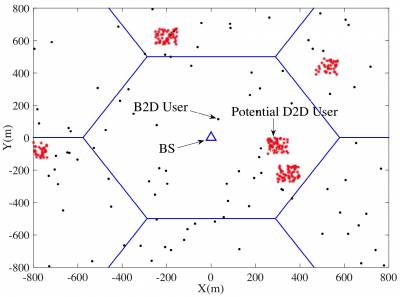Table of Contents
Home – Research – Members – Publication – Honor – Courses – Services – News – Openings
Spatial Spectrum Sensing-Based Device-to-Device (D2D) Networks
Personnel
- Principal Investigator: Lingjia Liu (ECE at VT)
- Student Investigator: Ramin Safavinejad (ECE at VT)
- Student Investigator: Nima Mohammadi (ECE at VT)
- Student Investigator: Yifei Song (ECE at VT)
- Industrial Collaborator: Jianzhong (Charlie) Zhang (Samsung Research America)
- Industrial Collaborator: Hao Chen (Samsung Research America)
- Academic Collaborator: Harpreet S. Dhillon (ECE at VT)
Abstract
The continuing growth of mobile data applications is expected to trigger a large increase in mobile traffic over the next decade. Direct device-to-device (D2D) communications between user devices that offload cellular network traffic has a great potential to be an integral part of the solution to address this mobile data challenge. In this project, the researchers will introduce a novel spectrum access model, called sensing-based D2D communication, to significantly improve the overall network spectral-efficiency of a mobile broadband network. In sensing-based D2D, users utilize spatial spectrum sensing to explore temporal and spatial spectrum transmission opportunities within the underlying cellular network bands. Equipped with spatial spectrum sensing, these users can efficiently utilize the available non-occupied cellular spectrum while providing enough protection to legacy base-station-to-device users. This project will result in a new enabling technology for future mobile broadband networks and will also effectively enrich educational materials by providing software and hardware-based implementation and experimental activities.
The research project has three interconnected thrusts. In the first thrust, a comprehensive framework for both theoretical analysis and practical design of sensing-based D2D that connects the user-driven spatial spectrum sensing to the overall network performance will be developed, using detection theory and stochastic geometry. In the second thrust, optimal system design and resource allocation of sensing-based D2D will be identified. Existing techniques, such as distributed caching and millimeter wave communications, will be integrated into sensing-based D2D. In the third thrust, the performance of the developed schemes will be evaluated using both software and hardware test-beds to obtain ideas on real-world performance. The key aspect of the proposed research is that the success of the project will lead to a big shift from currently popular design methodologies used for wireless networks and can provide a comprehensive response to mobile data growth challenge under realistic system assumptions.
Publication
- B. Shang, E. S. Bentley and L. Liu, “UAV Swarm-Enabled Aerial Reconfigurable Intelligent Surface: Modeling, Analysis, and Optimization,” IEEE Trans. Commun., vol. 71, no. 6, pp. 3621-3636, June 2023.
- B. Shang, L. Liu, H. Chen, J. Zhang, S. Pudlewski, E. Bentley, and J. Ashdown, “Spatial Spectrum Sensing in Uplink Two-Tier User-Centric Deployed HetNets,” IEEE Trans. Wireless Commun., vol. 19, no. 12, pp. 7957-7972, Dec. 2020.
- K. Hamedani, L. Liu, S. Liu, H. He, and Y. Yi, “Deep Spiking Delayed Feedback Reservoirs and Its Application in Spectrum Sensing of MIMO-OFDM Dynamic Spectrum Sharing”, AAAI Conf Artificial Intell. (AAAI-2020), vol. 34, no. 2, pp. 1292-1299, 2020.
- B. Shang, L. Liu, R. M. Rao, V. Marojevic and J. H. Reed, “3D Spectrum Sharing for Hybrid D2D and UAV Networks,” IEEE Trans. Commun., vol. 68, no. 9, pp. 5375-5389, Sept. 2020.
- B. Shang and L. Liu, “Mobile Edge Computing in the Sky: Energy Optimization for Air-Ground Integrated Networks,” accepted to IEEE Internet Things J., vol. 7, no. 8, pp. 7443-7456, Aug. 2020.
- B. Shang, V. Marojevic, Y. Yi, A. S. Abdalla and L. Liu, “Spectrum Sharing for UAV Communications: Spatial Spectrum Sensing and Open Issues,” IEEE Veh. Technol. Mag., vol. 15, no. 2, pp. 104-112, June 2020.
- B. Shang and L. Liu, “Machine Learning Meets Point Process: Spatial Spectrum Sensing in User-Centric Networks,” IEEE Wireless Commun. Lett., vol. 9, no. 1, pp. 34-37, Jan. 2020.
- B. Shang, L. Liu, H. Chen, J. Zhang, S. Pudlewski, E. Serena Bentley, and J. Ashdown, “Spatial Spectrum Sensing-Based D2D Communications in User-Centric Deployed HetNets”, 2019 IEEE Global Commun. Conf. (GLOBECOM), Waikoloa USA, 2019 pp. 1-6.
- F. Mahmood, E. Perrins and L. Liu, “Energy-Efficient Wireless Communications: From Energy Modeling to Performance Evaluation,” IEEE Trans. Veh. Technol., vol. 68, no. 8, pp. 7643-7654, Aug. 2019.
- A. Akhtar, J. Ma, R. Shafin, J. Bai, L. Li, Z. Li, and L. Liu, “Low Latency Scalable Point Cloud Communication in VANETs using V2I Communication”, 2019 IEEE Intl Conf. on Commun. (ICC), Shanghai, China, 2019, pp. 1-7.
- H. Song, L. Liu, H. Chang, J. Ashdown, and Y. Yi, “Deep Q-Network Based Power Allocation Meets Reservoir Computing in Distributed Dynamic Spectrum,” 2019 IEEE Conf. on Computer Commun. Workshops (INFOCOM WKSHPS), Paris, France, pp. 774-779.
- H. Chen, L. Liu, H. S. Dhillon and Y. Yi, “QoS-Aware D2D Cellular Networks with Spatial Spectrum Sensing: A Stochastic Geometry View,” IEEE Trans. on Commun., vol. 67, no. 5, pp. 3651-3664, May 2019.
- C. Sahin, L. Liu, E. Perrins, and L. Ma, “Delay-Sensitive Communications over IR-HARQ: Modulation, Coding Latency, and Reliability”, Special Issue on Ultra-Reliable Low-Latency Communications in Wireless Networks, IEEE J. Sel. Area Commun., vol. 37, no. 4, pp. 749 - 764, April 2019.
- R. Atat, L. Liu, J. Wu, G. Li, C. Ye and Y. Yang, “Big Data Meet Cyber-Physical Systems: A Panoramic Survey,” IEEE Access, vol. 6, pp. 73603-73636, 2018.
- R. Atat, J. Ma, H. Chen, U. Lee, J. Ashdown and L. Liu, “Cognitive relay networks with energy and mutual-information accumulation,” 2018 IEEE Conf. on Computer Commun. Workshops (INFOCOM WKSHPS), Honolulu, HI, April 2018, pp. 640-644.

